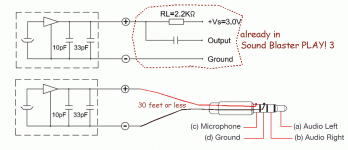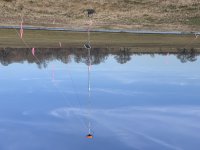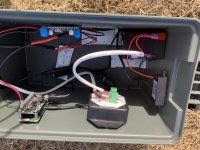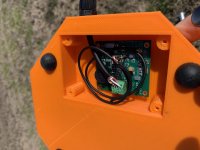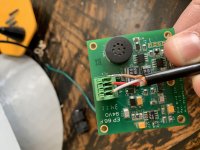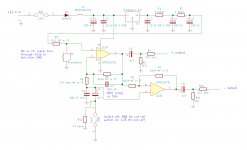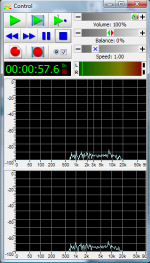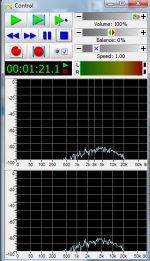Hello all, first time poster here. A little background on me and my project. I am a wildlife biologist that is currently pursuing bioacoustic projects. The specific project I currently need help with is night flight calls given by migrating birds. These sounds are are usually concentrated in the 5-8khz range with outliers on both sides (black-billed cuckoos are very low and some sparrows are over 10khz).
My setup uses a raspberry pi with a sound blaster play 3 audio interface as the recorder. I am using the POM-2730L-HD-R (http://www.puiaudio.com/pdf/POM-2730L-HD-R.pdf) and use the recommended drive circuit in the datasheet. I currently use a preamp designed by old bird, Inc (Old Bird 21c), but they are expensive and hard to get as a stand alone item. I don't know much about how that preamp works other than it runs off 9-12V single supply and passes on 5V to an electret element. The preamp is balanced too. My setup runs off a 12V solar powered battery that powers the raspberry pi. The raspberry pi sends out 5V to a 9V step up converter that then powers the preamp.
I am in need of a preamp design that I can make at home (have some skill in putting components together) or purchase one that would suite my needs. What I am looking for is an ultra low-noise, balanced, linear, single supply (12 volt preferably) electret preamp that I can build myself or buy. I would prefer it have set gain levels to limit variables when setting up the "Night Flight Call Stations". Gain could then be set using the audio interface.
Any advice and criticisms are greatly appreciated.
My setup uses a raspberry pi with a sound blaster play 3 audio interface as the recorder. I am using the POM-2730L-HD-R (http://www.puiaudio.com/pdf/POM-2730L-HD-R.pdf) and use the recommended drive circuit in the datasheet. I currently use a preamp designed by old bird, Inc (Old Bird 21c), but they are expensive and hard to get as a stand alone item. I don't know much about how that preamp works other than it runs off 9-12V single supply and passes on 5V to an electret element. The preamp is balanced too. My setup runs off a 12V solar powered battery that powers the raspberry pi. The raspberry pi sends out 5V to a 9V step up converter that then powers the preamp.
I am in need of a preamp design that I can make at home (have some skill in putting components together) or purchase one that would suite my needs. What I am looking for is an ultra low-noise, balanced, linear, single supply (12 volt preferably) electret preamp that I can build myself or buy. I would prefer it have set gain levels to limit variables when setting up the "Night Flight Call Stations". Gain could then be set using the audio interface.
Any advice and criticisms are greatly appreciated.
Play!3 sound card page
manual?
The POM's suggested interface is SO conventional that it is surely already inside this Play!3 USB audio "card" along with a good amount of gain. The mike/headphone jack is wired strange and you will need the funny 4-wire plug (though only two are connected here). That will get audio into the Play!3 and onto USB for the computer to sense and record.
These are fly-over birds? Nobody ever paid me to record those (I've had stranger gigs, not this one). Obviously you don't have "room sound" and the performers can't be told to stand close to the mike-- it may be quite weak. But try it and see how much more gain is needed.
manual?
The POM's suggested interface is SO conventional that it is surely already inside this Play!3 USB audio "card" along with a good amount of gain. The mike/headphone jack is wired strange and you will need the funny 4-wire plug (though only two are connected here). That will get audio into the Play!3 and onto USB for the computer to sense and record.
These are fly-over birds? Nobody ever paid me to record those (I've had stranger gigs, not this one). Obviously you don't have "room sound" and the performers can't be told to stand close to the mike-- it may be quite weak. But try it and see how much more gain is needed.
Attachments
Do you need high-pass filtering? When I record birds from a distance, I usually record lots of wind noise with very faint bird sounds. As the wind is at much lower frequencies than the birds, some high-pass filtering will solve that, provided the wind didn't make anything clip. A bit of filtering up-front may help to prevent clipping.
Anyway, if I calculated it correctly, the output noise level of the microphone is -104 dBV A-weighted, which in the case of white noise would correspond to about 55 nV/sqrt(Hz). It may well be lower in the frequency range that you are interested in, though, as the microphone will be noisier at low than at high frequencies (bias resistor noise and FET 1/f noise drop with frequency).
All in all, I would expect that an amplifier equivalent input noise level of 10 nV/sqrt(Hz) or so would be low enough not to cause noticeable degradation. That's fairly low, but not ultra low. A decent low-noise op-amp and a few resistors and capacitors should do the trick.
Regarding PRR's suggestion to see how far you get without preamplifier: it's a pity, but there is no information whatsoever about the microphone input's noise level in the soundcard documentation PRR found. Since the noise requirements are not that tough, chances are it will work fine, but you will have to determine that by just trying it.
By the way, why do you want a balanced output when the sound card has no balanced inputs?
Anyway, if I calculated it correctly, the output noise level of the microphone is -104 dBV A-weighted, which in the case of white noise would correspond to about 55 nV/sqrt(Hz). It may well be lower in the frequency range that you are interested in, though, as the microphone will be noisier at low than at high frequencies (bias resistor noise and FET 1/f noise drop with frequency).
All in all, I would expect that an amplifier equivalent input noise level of 10 nV/sqrt(Hz) or so would be low enough not to cause noticeable degradation. That's fairly low, but not ultra low. A decent low-noise op-amp and a few resistors and capacitors should do the trick.
Regarding PRR's suggestion to see how far you get without preamplifier: it's a pity, but there is no information whatsoever about the microphone input's noise level in the soundcard documentation PRR found. Since the noise requirements are not that tough, chances are it will work fine, but you will have to determine that by just trying it.
By the way, why do you want a balanced output when the sound card has no balanced inputs?
Last edited:
Play!3 sound card page
manual?
The POM's suggested interface is SO conventional that it is surely already inside this Play!3 USB audio "card" along with a good amount of gain. The mike/headphone jack is wired strange and you will need the funny 4-wire plug (though only two are connected here). That will get audio into the Play!3 and onto USB for the computer to sense and record.
These are fly-over birds? Nobody ever paid me to record those (I've had stranger gigs, not this one). Obviously you don't have "room sound" and the performers can't be told to stand close to the mike-- it may be quite weak. But try it and see how much more gain is needed.
Thank you for that advice and diagram. I have two more sound blasters on order and will give that a shot. The preamp I am using may have some circuitry that accentuates certain frequencies. Is that possible? I believe it has a high-pass filter built into it.
I wish someone was paying me to work on this project. Alas, it is very much a passion project. Thanks again.
Do you need high-pass filtering? When I record birds from a distance, I usually record lots of wind noise with very faint bird sounds. As the wind is at much lower frequencies than the birds, some high-pass filtering will solve that, provided the wind didn't make anything clip. A bit of filtering up-front may help to prevent clipping.
Anyway, if I calculated it correctly, the output noise level of the microphone is -104 dBV A-weighted, which in the case of white noise would correspond to about 55 nV/sqrt(Hz). It may well be lower in the frequency range that you are interested in, though, as the microphone will be noisier at low than at high frequencies (bias resistor noise and FET 1/f noise drop with frequency).
All in all, I would expect that an amplifier equivalent input noise level of 10 nV/sqrt(Hz) or so would be low enough not to cause noticeable degradation. That's fairly low, but not ultra low. A decent low-noise op-amp and a few resistors and capacitors should do the trick.
Regarding PRR's suggestion to see how far you get without preamplifier: it's a pity, but there is no information whatsoever about the microphone input's noise level in the soundcard documentation PRR found. Since the noise requirements are not that tough, chances are it will work fine, but you will have to determine that by just trying it.
By the way, why do you want a balanced output when the sound card has no balanced inputs?
Thank you for the great info. I will certainly need to decipher and digest. I do think the current preamp I am using has some high-pass filter built in. The microphone and preamp are mounted on a pole about 25ft in the air and the cable run is about 30ft. Not really sure I need it to be balanced or not. Your thoughts? I will try to post some pictures of my set-up soon.
Below are some photos of the avian "Night Flight Call Station". I also included a diagram of how I connect the preamp to the Sound Blaster Play! 3.
Attachments
Do you expect to ever replace the sound card with a professional or semi-professional model, or to install a signal transformer between the microphone preamplifier and the sound card? If not, there is not much point in having a balanced preamplifier output. Right now you have a balanced output, but you hook it up single-endedly, so a single-ended output would work just as well.
I saw in a link of a document you linked to in the opening post that your present amplifier has a 1 kHz high-pass built in that you can defeat for black- and yellow-billed cuckoos, herons and bitterns. If you go for a DIY amplifier, would you also want it to have a high-pass at 1 kHz or would you want to reduce it to some frequency that also suits black-billed cuckoos? If so, do you know how low a black-billed cuckoo goes in frequency?
If you give me a few days, I can come up with a very basic microphone amplifier and high-pass filter circuit that you could build yourself, if a direct connection to the sound card's microphone input should not work well enough. It will be at your own risk, of course, but as it will be very simple the risk that it won't work will be very small. Do you have a strong preference for through-hole components or are SMDs acceptable when they are not too small?
I saw in a link of a document you linked to in the opening post that your present amplifier has a 1 kHz high-pass built in that you can defeat for black- and yellow-billed cuckoos, herons and bitterns. If you go for a DIY amplifier, would you also want it to have a high-pass at 1 kHz or would you want to reduce it to some frequency that also suits black-billed cuckoos? If so, do you know how low a black-billed cuckoo goes in frequency?
If you give me a few days, I can come up with a very basic microphone amplifier and high-pass filter circuit that you could build yourself, if a direct connection to the sound card's microphone input should not work well enough. It will be at your own risk, of course, but as it will be very simple the risk that it won't work will be very small. Do you have a strong preference for through-hole components or are SMDs acceptable when they are not too small?
Do you expect to ever replace the sound card with a professional or semi-professional model, or to install a signal transformer between the microphone preamplifier and the sound card? If not, there is not much point in having a balanced preamplifier output. Right now you have a balanced output, but you hook it up single-endedly, so a single-ended output would work just as well.
I saw in a link of a document you linked to in the opening post that your present amplifier has a 1 kHz high-pass built in that you can defeat for black- and yellow-billed cuckoos, herons and bitterns. If you go for a DIY amplifier, would you also want it to have a high-pass at 1 kHz or would you want to reduce it to some frequency that also suits black-billed cuckoos? If so, do you know how low a black-billed cuckoo goes in frequency?
If you give me a few days, I can come up with a very basic microphone amplifier and high-pass filter circuit that you could build yourself, if a direct connection to the sound card's microphone input should not work well enough. It will be at your own risk, of course, but as it will be very simple the risk that it won't work will be very small. Do you have a strong preference for through-hole components or are SMDs acceptable when they are not too small?
This is great to hear and very much appreciated. I am afraid that I don't know if I need to install a signal transformer or not. The raspberry pi software is limited to certain sound cards, but I am planning on switching over to the isolated Audio Injector (This is great to hear and very much appreciated. I am afraid that I don't know if I need to install a signal transformer or not. The raspberry pi software is limited to certain sound cards, but I am planning on switching over to the isolated Audio Injector (Audio Injector isolated DAC & ADC (Raspberry Pi compatible) by Flatmax Studios — Kickstarter) when they become available (not sure with the virus how long that may be). However, I am open to any advice on this matter. I think having a 1kHz high-pass filter would work great. Some species have low frequency calls but they typically center around 2kHz. I think I can manage soldering some of the larger SMDs. Thanks again for all your help!
Last edited:
> there is no information whatsoever about the microphone input's noise level
It's a $20 device. I would not expect much info.
I do not know why *that* device. Basic "sound card" interface has not changed since the 1990s, the Pi should be able to take bits from almost anything.
The USB side of the device can be extended cleaner than the analog side.
If it gets into the digital domain it can be low-cut there.
I can't help thinking there may be a better place than a Hi-Fi forum.
It's a $20 device. I would not expect much info.
I do not know why *that* device. Basic "sound card" interface has not changed since the 1990s, the Pi should be able to take bits from almost anything.
The USB side of the device can be extended cleaner than the analog side.
If it gets into the digital domain it can be low-cut there.
I can't help thinking there may be a better place than a Hi-Fi forum.
I've designed integrated circuits for dirt-cheap consumer electronics since 1995, and there is always a long list of specifications that need to be met, verified and validated, with detailed lists of measuring and simulation conditions. In fact, I spent yesterday evening browsing through sound card CODEC chip datasheets, and although they are also incomplete, they are far more informative than the small list of numbers without any measuring conditions given by Creative for their Sound Blaster cards.
As far as I'm concerned, the only reason for having some high-pass filtering on the analog side is to prevent clipping by loud wind noises while recording at a gain that is high enough not to increase the noise floor noticeably. If the dynamic range of the sound card were much greater than that of the microphone, filtering could be completely done on the digital side, but actually the dynamic range of a cheap sound card is of the same order as the 90 dB(A) dynamic range of the microphone, so it can be useful to have some attenuation of loud irrelevant sounds.
As far as I'm concerned, the only reason for having some high-pass filtering on the analog side is to prevent clipping by loud wind noises while recording at a gain that is high enough not to increase the noise floor noticeably. If the dynamic range of the sound card were much greater than that of the microphone, filtering could be completely done on the digital side, but actually the dynamic range of a cheap sound card is of the same order as the 90 dB(A) dynamic range of the microphone, so it can be useful to have some attenuation of loud irrelevant sounds.
I was able to straight wire the POM mic into the sound card. I maxed out the gain setting at +30dB and it was not nearly enough unfortunately (the mic does sound a lot better without that circuitry I had in it previously). I am not sure at what fixed gain setting the current preamp I use is at and I don't know how to figure that out with what I have on hand. That being said, I think a preamp will be necessary for this project to work.
What criterion do you use to determine whether it is enough?
As an RF designer, I would say you need enough gain to amplify the microphone's noise well above the noise floor of the sound card and preferably not more than that. If the sound is then still rather weak, you can just amplify it digitally without losing performance compared to what you would have got with more analog amplification. If you agree with that, then based on what I read in sound card chip datasheets, an analog gain of about 25 (that is, 28 dB) between microphone and sound card should be sufficient.
This assumes that the background noise is indeed noise from the microphone and sound card, and not interference from the Raspberry Pi or anything else that might interfere. Is that assumption correct?
Regarding figuring out the gain of the present amplifier, if you have something that produces a more or less constant sound level (maybe your own voice, although something above 1 kHz would be preferable), you could record it with and without preamplifier with equal sound card settings. If you WeTransfer the results to me, I can put them into an audio editing program and see how much level difference there is above 1 kHz.
As an RF designer, I would say you need enough gain to amplify the microphone's noise well above the noise floor of the sound card and preferably not more than that. If the sound is then still rather weak, you can just amplify it digitally without losing performance compared to what you would have got with more analog amplification. If you agree with that, then based on what I read in sound card chip datasheets, an analog gain of about 25 (that is, 28 dB) between microphone and sound card should be sufficient.
This assumes that the background noise is indeed noise from the microphone and sound card, and not interference from the Raspberry Pi or anything else that might interfere. Is that assumption correct?
Regarding figuring out the gain of the present amplifier, if you have something that produces a more or less constant sound level (maybe your own voice, although something above 1 kHz would be preferable), you could record it with and without preamplifier with equal sound card settings. If you WeTransfer the results to me, I can put them into an audio editing program and see how much level difference there is above 1 kHz.
What criterion do you use to determine whether it is enough?
As an RF designer, I would say you need enough gain to amplify the microphone's noise well above the noise floor of the sound card and preferably not more than that. If the sound is then still rather weak, you can just amplify it digitally without losing performance compared to what you would have got with more analog amplification. If you agree with that, then based on what I read in sound card chip datasheets, an analog gain of about 25 (that is, 28 dB) between microphone and sound card should be sufficient.
Regarding figuring out the gain of the present amplifier, if you have something that produces a more or less constant sound level (maybe your own voice, although something above 1 kHz would be preferable), you could record it with and without preamplifier with equal sound card settings. If you WeTransfer the results to me, I can put them into an audio editing program and see how much level difference there is above 1 kHz.
This is a great suggestion. I have been using a yellow-throated warbler recording I have to come up with the sound card gain settings. If I understand what you're suggesting is that I would bump up the gain on the sound card to around 28dB and then digitally amplify/normalize to a certain level. That would be better than using a preamp and lower gain setting on the sound card? Thanks again for your help!
No, that's not what I meant. What I mean is that a preamplifier gain of about 28 dB should definitely be enough, based on what I read in sound card chip datasheets. If the sound is still too weak with a 28 dB preamplifier, you could digitally amplify/normalize it further.
Whether you need a preamplifier at all is still an open question for me. Unfortunately the datasheets specify very little about what happens when the sound card chip gain is cranked up.
Whether you need a preamplifier at all is still an open question for me. Unfortunately the datasheets specify very little about what happens when the sound card chip gain is cranked up.
No, that's not what I meant. What I mean is that a preamplifier gain of about 28 dB should definitely be enough, based on what I read in sound card chip datasheets. If the sound is still too weak with a 28 dB preamplifier, you could digitally amplify/normalize it further.
Whether you need a preamplifier at all is still an open question for me. Unfortunately the datasheets specify very little about what happens when the sound card chip gain is cranked up.
Gotcha, I will do some test recordings for you using the sound card alone and with the preamp. Thanks!
That is, with a 28 dB preamplifier with reasonably low noise and the sound card set to 0 dB, the noise will be totally dominated by the microphone.
Without a preamplifier, you definitely have to set the sound card to maximum gain, but I haven't a clue whether or not the noise will then be totally dominated by the microphone. That's because I didn't find enough information about sound card performance at high gain settings.
Without a preamplifier, you definitely have to set the sound card to maximum gain, but I haven't a clue whether or not the noise will then be totally dominated by the microphone. That's because I didn't find enough information about sound card performance at high gain settings.
There is a simple experiment to determine whether the sound card noise is well below the microphone noise, which would make a preamplifier unnecessary:
A. Record silence with the microphone connected and the sound card at maximum gain
B. Record silence with the microphone disconnected and the sound card settings exactly as in step A
C. Compare the noise levels of both recordings; if the noise in step A is considerably stronger than in step B, the sound card's noise is low enough. For example, when the noise in step A is at least 7 dB stronger than in step B, the sound card contributes less than 1 dB to the total noise.
If the sound card's noise level is low enough, the next question is whether in normal use, the sound card would get driven into clipping by low-frequency sounds such as wind. If so, you may still need an analog high-pass filter - and then it makes sense to build a preamplifier with built-in high-pass after all.
A. Record silence with the microphone connected and the sound card at maximum gain
B. Record silence with the microphone disconnected and the sound card settings exactly as in step A
C. Compare the noise levels of both recordings; if the noise in step A is considerably stronger than in step B, the sound card's noise is low enough. For example, when the noise in step A is at least 7 dB stronger than in step B, the sound card contributes less than 1 dB to the total noise.
If the sound card's noise level is low enough, the next question is whether in normal use, the sound card would get driven into clipping by low-frequency sounds such as wind. If so, you may still need an analog high-pass filter - and then it makes sense to build a preamplifier with built-in high-pass after all.
Last edited:
Based on two wave files Hal sent, the present preamp has a gain between 50 dB and 60 dB, best estimate 57 dB, and a second-order high-pass with rather low Q factor. There is something weird about the noise: when the recording without preamplifier is digitally amplified to get the same level as the one with preamplifier, its noise floor is considerably lower than the noise floor with preamplifier - which either means it is a very poor preamplifier, or that the bird used as a test signal did not sing equally loud.
First plot: no preamplifier, sound card at +30 dB, digitally filtered and amplified by another 27 dB
Second plot: with preamplifier, sound card at 0 dB
First plot: no preamplifier, sound card at +30 dB, digitally filtered and amplified by another 27 dB
Second plot: with preamplifier, sound card at 0 dB
Attachments
Based on two wave files Hal sent, the present preamp has a gain between 50 dB and 60 dB, best estimate 57 dB, and a second-order high-pass with rather low Q factor. There is something weird about the noise: when the recording without preamplifier is digitally amplified to get the same level as the one with preamplifier, its noise floor is considerably lower than the noise floor with preamplifier - which either means it is a very poor preamplifier, or that the bird used as a test signal did not sing equally loud.
First plot: no preamplifier, sound card at +30 dB, digitally filtered and amplified by another 27 dB
Second plot: with preamplifier, sound card at 0 dB
I believe this is good news for me? I believe you are saying I get better performance without the preamp by maxing out the gain on the sound card and then amplifying/normalizing the recordings on the backend? I can also choose to or not to implement a high-pass filter on the backend as well, right? This would drastically simplify my setup and make it considerably cheaper as the preamps I was using cost $75 USD each.
- Home
- General Interest
- Everything Else
- Need Advice for a Weird Project
